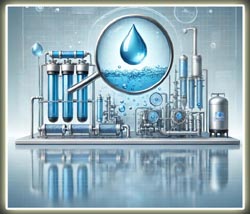


Reverse osmosis (RO) technology is widely used in industries and municipalities for water purification.
However, maintaining an RO plant efficiently requires proper care, regular monitoring, and timely interventions. Without proper upkeep, system performance can decline, leading to increased operational costs and reduced water quality. Below are essential maintenance tips to ensure long-term efficiency and durability of your RO system.
1. Regular Monitoring of Water Quality
One of the most critical aspects of maintaining an RO system is monitoring the quality of feed water and permeate water. Any significant change in water quality, such as increased total dissolved solids (TDS) or bacterial contamination, could indicate membrane fouling or system inefficiencies. Conduct regular tests to detect potential issues early and take corrective actions promptly.
2. Proper Pre-Treatment Measures
An RO system’s performance largely depends on its pre-treatment process. Poor pre-treatment can lead to membrane scaling, fouling, and reduced filtration efficiency. Ensure that pre-filters, softeners, and chemical dosing systems are functioning optimally to prevent damage to the RO membranes. Using anti-scalants and maintaining appropriate pH levels can also prolong membrane life.
3. Routine Cleaning of RO Membranes
Over time, membranes accumulate dirt, biofilm, and mineral deposits, which can reduce water output and pressure levels. To maintain efficiency, schedule periodic membrane cleaning based on system performance indicators like increased differential pressure or decreased water flow. Using the right cleaning chemicals and procedures ensures membrane longevity and consistent filtration performance. Hire water plant – visit our website to find the right solution!
4. Regular Inspection of Pumps and Valves
Pumps and valves play a crucial role in maintaining optimal pressure and water flow within the system. Any malfunction in these components can disrupt operations and cause inefficiencies. Conduct routine inspections for leaks, unusual noises, or pressure fluctuations. Lubricate and replace parts as needed to prevent costly breakdowns.
5. Checking and Replacing Filters on Time
RO systems include multiple filters, such as sediment filters, carbon filters, and post-filters, which require timely replacements to maintain peak performance. Clogged or expired filters can reduce water flow and strain the membranes, leading to premature failure. Follow the manufacturer’s guidelines for filter replacement intervals to ensure smooth operation.
6. Maintaining Proper System Pressure
Maintaining the correct pressure levels is essential for efficient RO operation. Low pressure can result in poor water output, while excessive pressure can damage membranes and other components. Regularly check system pressure and adjust settings as needed to optimize filtration efficiency.
Author resource:-
Lee Wood writes about sustainable and scalable water and wastewater treatment solutions.
